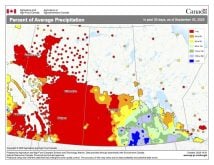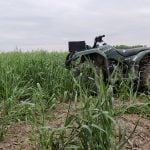After a dry to very dry winter and spring across agricultural Manitoba, there comes a time when we have to begin talking about the dreaded “D” word: drought. Looking up some definitions of drought, here is what I have found:
In the most general sense, drought originates from a deficiency of precipitation over an extended period of time — usually a season or more — resulting in a water shortage for some activity, group, or environmental sector.
Which then leads to this slightly more specific definition:
Drought is a protracted period of deficient precipitation resulting in extensive damage to crops, resulting in loss of yield.
Using the first definition, I would say we have definitely seen a deficiency of precipitation over an extended period of time. Table 1 (below) includes data I have put together showing the total amount of precipitation that has fallen from January to April of this year, the long-term average, and the driest period we have seen on record. In Table 2 (below) I’ve extended the time frame to cover November 2017 through to April 2018.
The first point of note is that all three locations have seen below-average amounts of precipitation over both of these time frames. The Winnipeg region has been the driest, with only around 33 per cent of average precipitation. Dauphin is the next driest, with around 50 per cent of average. Finally, the Brandon region came in with around 70 per cent of average. The Winnipeg region is the only area, at this level of examination, that has broken records for the driest November-to-April and January-to-April periods. In fact, Winnipeg easily broke both records with the January-to-April record going all the way back to 1875. So, if you are saying that this has been the driest winter and spring that you can ever remember, you are probably right, since the previous records for the Brandon and Dauphin regions occurred back in the mid-1920s and early 1930s.
Read Also

Farmer gift idea: How about a weather station?
The 2025 holiday season is looming, and a home weather station might make a great Christmas gift for farmers
We definitely have seen a deficiency of precipitation over an extended period of time — usually a season or more. Therefore, according to the first definition, we are now in a drought. Looking at the second definition, a drought occurs when a deficiency of precipitation results in extensive damage to crops. Since this year’s crops are not yet actively growing we can’t yet say that we have seen extensive damage. I know in my region with the wet Red River clay soils, most farmers are just finishing up seeding, so for them another week or so of dry weather is just perfect. I just finished tilling up my own three gardens and I must admit the soil and soil moisture levels were just about perfect. So, do we need to worry about drought?
While soil moisture levels have been good for getting on the land and planting, the lack of snowmelt and scarce spring rains have left very little available water. Water levels in rivers, streams and water bodies are low, along with ground water levels. So, while everything is good right now, there is very little capacity in the current water system to handle ongoing dry conditions. With the current prediction of warm, dry weather, it won’t take long before we begin to feel the adverse effects of dry weather. If the dry weather impacts germination and early-season growth, then we’ll quickly begin seeing extensive crop damage taking place — a drought based on the second definition above.
Now, it is easy to cry doom and gloom — heck, the potential is there — but we also know that dry weather has and can quickly turn into wet weather. Can we have a dry May and still be OK? I think so. June and July are the wettest months, with a majority of the rainfall coming from thunderstorms that are notoriously difficult to predict. What would suffer if we continue to see dry weather for the next couple of weeks would be a lot of the hayfields. With the dry winter and spring there was little standing water in the fields. This usually helps to warm the top level of soil and gets things actively growing. With the available soil moisture and with no rain, it looks to be a slow start to the growing season for hay. With a limited time period to get good growth before the summer heat hits, it may be the hayfields that feel the first impacts of drought.
Next issue we’ll continue to see how things are shaping up rain-wise, and then we’ll begin our annual look at thunderstorms, since thunderstorm season is pretty much upon us.


















